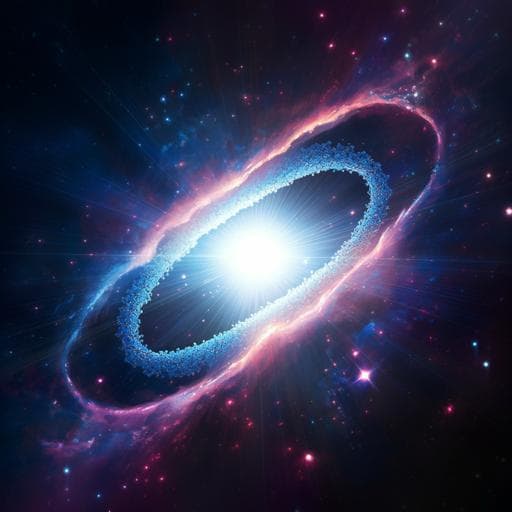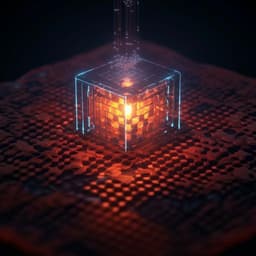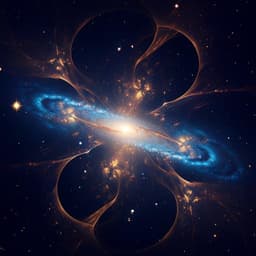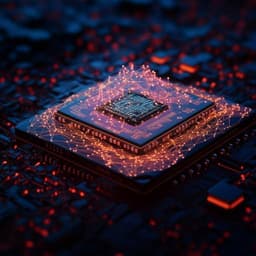
Physics
The silicon vacancy centers in SiC: determination of intrinsic spin dynamics for integrated quantum photonics
D. Liu, F. Kaiser, et al.
Discover the groundbreaking research on the negatively charged silicon vacancy center (Vs−) in silicon carbide by Di Liu and colleagues. This study reveals critical insights into its spin-optical dynamics and proposes protocols for generating entangled multi-photon states, advancing integrated quantum photonics.
~3 min • Beginner • English
Introduction
Solid-state spin qubits based on color centers in wide-bandgap semiconductors are leading candidates for quantum networks, information processing, and sensing due to robust spin–optical properties and long coherence times. Silicon carbide (SiC) is especially promising thanks to wafer-scale fabrication, isotopic engineering, and CMOS compatibility, enabling scalable quantum systems. Prior work has demonstrated millisecond room-temperature spin coherence, high-fidelity spin and optical control, coherent spin–photon interfaces, nuclear-spin entanglement, single-shot charge readout, and integration of negatively charged silicon vacancy centers (V−s) into nanophotonic waveguides and resonators. Among these, the cubic-site silicon vacancy (V2) in 4H-SiC is a strong contender for dense on-chip integration. However, achieving fully scalable integrated solutions requires a complete understanding of the intrinsic spin–optical dynamics to guide cavity–emitter engineering and optimization of spin and optical properties. In this work, the authors focus on the V2 center (larger ground-state ZFS than V1, enabling faster spin manipulation and higher fidelities) and reveal its comprehensive internal spin dynamics through theoretical electronic-structure characterization corroborated by experiments. They measure spin-selective excited-state lifetimes, ground-state spin initialization under resonant and off-resonant excitation, and metastable-state (MS) dynamics via spin manipulation with delayed pulses, thereby determining all spin-dependent radiative and non-radiative rates and identifying the ISC and deshelving mechanisms relevant for integrated quantum photonics and multi-photon entanglement generation.
Literature Review
The study builds on rapid advances in SiC spin qubits: coherent control and millisecond coherence at room temperature; high-fidelity spin and optical control; spin–photon interfaces; nuclear-spin register entanglement; single-shot charge readout; and integration into nanophotonic devices (waveguides, resonators). V2 centers have shown high spectral stability under resonant excitation and compatibility with SiC-on-insulator photonics. Prior theoretical treatments using group theory for V centers in 4H-SiC established the electronic structure and spin–photon interfaces. Earlier ISC models suggested doublet involvement but lacked critical states or orthonormality and did not identify pseudo–Jahn–Teller (PJT) effects or a deshelving state, leaving the ISC mechanism unresolved. Previous work on V1 reported nearly identical spin-dependent excited-state lifetimes and a single MS around ~200 ns, whereas V2 displays distinct dynamics due to stronger local symmetry distortion (C3v deviating from Td) and larger ZFS, motivating a revised, comprehensive model including spin–orbit and vibronic couplings and deshelving.
Methodology
- Theory and modeling: Group-theoretical framework (following Soykal et al.) constructs multi-particle symmetry-adapted total wavefunctions from single-electron molecular orbitals and linear combinations of localized sp3 orbitals. Many-body spin–orbit, spin–spin, and exchange interactions are considered to derive the fine structure. A simplified, equivalent rate model is developed comprising Kramers-degenerate ground (GS) and excited (ES) spin subspaces (ms = ±1/2, ±3/2) and effective metastable states (MS1 and MS2), capturing ISC (upper: ES→MS via spin–orbit and phonons; lower: MS→GS) and a laser-driven deshelving pathway via a higher-lying uve doublet. PJT vibronic coupling (e-symmetry acoustic phonons) between ve2 and e′ doublets is included to model rapid redistribution within MS1. Power-dependent deshelving is represented via power-dependent decay rates.
- Experimental setup: Home-built scanning confocal microscope at 5.5 K in a closed-cycle cryostat. Resonant excitation: tunable single-frequency diode laser at 916.5 nm (Toptica DLC DL pro), with AOM and electro-optic modulator enabling CW and pulsed operation. Off-resonant excitation at 730 nm (custom diode laser). Excitations combined in a polarization-maintaining fiber, focused with a 100x, NA 0.9 objective. Emission collected on phonon sideband (940–1033 nm) and detected by a superconducting nanowire single-photon detector. Sample preparation and solid immersion lens as in prior work.
- Spin-dependent ES lifetime measurement: Charge-state repump (730 nm), followed by a sub-lifetime 1.5 ns resonant pulse at 916.5 nm on O1 or O2; fluorescence decay collected and fit to single exponentials to extract ES lifetimes.
- Probing MS dynamics: Sequences exploiting (i) off-resonant excitation to pump into MS with partial spin polarization, (ii) resonant pumping on O1 or O2 to achieve near-complete polarization into ms = ±3/2 or ±1/2, respectively, and (iii) resonant readout of spin populations. Spin-Rabi oscillations at 70 MHz (GS ZFS) used to determine absolute GS population contrast as a function of off-resonant repump duration and power.
- Delayed-pulse MS depopulation: A 4 μs off-resonant pulse at 4 mW traps population in MS; after a variable delay T_delay, a short (0.1 μs) resonant readout (O1 or O2) integrates fluorescence to map MS→GS relaxation, capturing incoming (γ1,2,11,22) and outgoing (γ3,4) ISC rates.
- Power-dependent resonant excitation: Following repump (32 μW, 40 μs), resonant pumping (O1 or O2) for up to 40 μs at powers 6–20 nW records time-dependent fluorescence decay to quantify depopulation dynamics and deshelving-induced power dependence of MS lifetimes.
- Parameter inference: Density-matrix master-equation modeling with Lindblad terms for radiative and non-radiative processes; Hamiltonian includes power-dependent Rabi frequency and detuning. A custom optimization (Nelder–Mead and differential evolution) simultaneously fits PL decays across four powers and delayed-pulse data, constrained by measured ES lifetimes, to extract all transition rates and MS lifetimes, including power-dependent deshelving via uve.
Key Findings
- Electronic fine structure and ISC: Comprehensive model identifies spin–orbit and vibronic (PJT) mechanisms governing ISC: ES quartet (A2: ue2) couples to higher-lying doublets (E: ve, A1: ve2), followed by rapid vibronic relaxation to e′ (MS1), then non-radiative decay to GS quartet. A separate ve doublet (MS2) exhibits weak relaxation and long lifetime. A previously unrecognized optical deshelving pathway promotes population from ve (MS2) to uve, which non-radiatively returns to UE ES, producing power-dependent MS2 lifetime.
- Spin-dependent excited-state lifetimes (bulk V2): O1 (ms = ±1/2) lifetime 6.1 ns; O2 (ms = ±3/2) lifetime 11.3 ns. The longer O2 lifetime indicates slower ISC for ms = ±3/2 and higher quantum efficiency for O2.
- Off-resonant pumping steady-state GS populations: At 30 μW off-resonant power, steady state reached after ~40 μs with GS population ratio favoring ms = ±1/2 of 0.57/0.43. At 4 mW, re-excitation (deshelving) can adjust the ratio to ~0.65/0.35.
- Resonant spin initialization fidelities: Using 6 nW resonant pumping for T > 20 μs, initialization fidelities of 95(1)% into ms = ±1/2 (O2) and 93(1)% into ms = ±3/2 (O1). From time-resolved resonant pumping, state initialization fidelity ~99.5(1)% (lower bound from spin-Rabi limited by residual magnetic field).
- Metastable-state lifetimes and power dependence: Two effective MSs are required. MS1 (ve2/e′) exhibits a lifetime comparable to ~200 ns (consistent with earlier V1 results); MS2 (ve) is long-lived and power dependent due to deshelving, reaching up to ~3 μs at low resonant powers. From fitted rates (reference 20 nW) and inferred powers: at 6 nW, total MS lifetime 1/(γ3+γ4) ≈ 5929 ns with MS2 ≈ 2964 ns; at 10 nW, 1/(γ3+γ4) ≈ 4378 ns, MS2 ≈ 2189 ns; at 15 nW, 1/(γ3+γ4) ≈ 2171 ns, MS2 ≈ 1085 ns; at 20 nW, 1/(γ3+γ4) ≈ 1482 ns, MS2 ≈ 741 ns.
- Validation: Simulations based on the inferred rates accurately reproduce delayed-pulse MS depopulation dynamics and power-dependent resonant decay data.
- Multi-photon entanglement protocol: A time-bin entanglement scheme uses O2 excitation and microwave control to generate N-photon GHZ or cluster states. Excitation error analysis (detuning between O1 and O2 ~1 GHz) yields an optimized square-pulse duration ~0.9 ns for three-photon states with excitation fidelity ~74.3%. Requirements for Purcell enhancement factors to reach fidelities are quantified; two-photon GHZ/cluster states are feasible with current SiC nanophotonic resonators; up to three-photon GHZ/cluster states are within reach (as also emphasized in the abstract).
Discussion
The work addresses the lack of a complete, experimentally validated model of intrinsic spin–optical dynamics for the V2 silicon vacancy center in 4H-SiC. By combining group-theoretical electronic-structure modeling with targeted spin-dependent optical measurements and master-equation fitting, the study identifies all critical radiative and non-radiative transition rates, clarifies the ISC pathways, and reveals a previously unrecognized deshelving mechanism via a higher-lying uve doublet. The measured spin-dependent ES lifetimes directly explain the higher quantum efficiency of the O2 transition (ms = ±1/2), which is advantageous for integration with nanophotonic resonators and for spin–photon interfaces. The two-effective-MS structure (with MS2 long-lived and power dependent) reconciles prior experimental observations, including anti-Stokes excitation, ODMR with off-resonant readout, and photon correlation measurements in resonators. Using the inferred intrinsic rates, the authors design realistic protocols for generating time-bin entangled multi-photon GHZ and cluster states from a single V2 center, derive state fidelities with contributions from excitation and branching errors, and specify optimal pulse timings and Purcell-factor requirements. This demonstrates how intrinsic emitter dynamics directly inform and constrain quantum network and photonic resource generation protocols, providing engineering guidelines for cavity coupling and operational regimes.
Conclusion
This work delivers a comprehensive, experimentally validated description of the intrinsic spin–optical dynamics of the V2 silicon vacancy center in 4H-SiC, including all relevant spin-selective radiative and non-radiative rates, ISC pathways mediated by spin–orbit and vibronic (PJT) couplings, and a novel optical deshelving mechanism via uve. Key experimental findings include distinct spin-dependent excited-state lifetimes (O1: 6.1 ns; O2: 11.3 ns), high-fidelity resonant spin initialization (up to ~99.5%), and the identification of two effective metastable states with a long-lived, power-dependent MS2. Leveraging these intrinsic rates, the authors propose practical protocols for generating time-bin entangled multi-photon GHZ and cluster states from a single V2 center, showing two-photon states are readily achievable with current SiC resonators and up to three photons are within reach with realistic Purcell enhancements. Future work should focus on phonon or strain engineering to increase excited-state ZFS and improve branching ratios, further suppress excitation errors, and enhance cavity-emitter coupling to scale to larger entangled photon states and to optimize performance in quantum networking and photonics.
Limitations
- Experimental conditions are at cryogenic temperature (5.5 K); temperature dependence of inferred rates and ISC/deshelving mechanisms is not fully explored here.
- Resonant powers were limited (≤20 nW) to avoid photo-ionization and power broadening; behavior at higher resonant powers was not characterized.
- Residual magnetic fields affected spin-Rabi-based initialization fidelity estimates (providing a lower bound) without an applied large external field for complete suppression.
- Multi-photon entanglement protocols beyond two to three photons require improved Purcell factors and reduced excitation/branching errors; demonstrated fidelities are based on modeling and inferred rates rather than a full experimental realization of multi-photon states.
- Table formatting limitations in the text notwithstanding, detailed partitioning of total MS lifetimes between channels relies on model fits; direct time-resolved spectroscopy of individual MS sublevels is challenging.
Related Publications
Explore these studies to deepen your understanding of the subject.







